What is Direct Current, definition, formula, circuits, applications and FAQs to know?
Direct Current (DC) refers to the flow of electric charge in a circuit that always moves in one direction. This is in contrast to Alternating Current (AC), which periodically reverses direction. Direct current can be generated using batteries, solar cells, or by converting AC power to DC power using devices called rectifiers.
What is direct current? definition.

What is direct current? answer to this question you want to know. Direct current (DC) refers to the flow of electric charge in a circuit that always moves in one direction. This is in contrast to Alternating Current (AC), which periodically reverses direction. Direct current can be generated using batteries, solar cells, or by converting AC power to DC power using devices called rectifiers.
What is Direct Current? Formula:
The formula for calculating the direct current flowing through a circuit is:
I = V/R
Where:
- I = Direct current (in amperes)
- V = Voltage (in volts)
- R = Resistance (in ohms)
What is Direct Current? Some facts about Direct Current.
- DC is the type of current produced by batteries, which is commonly used in portable electronic devices.
- The voltage of DC can be easily regulated using devices called voltage regulators, which maintain a constant voltage output even as the load on the circuit changes.
- DC can be stored in batteries, capacitors, and other energy storage devices, making it a useful source of backup power.
- Unlike AC, which can cause interference in electronic devices, DC produces very little electromagnetic interference (EMI).
- The direction of DC can be changed using devices called switches, which allow the current to flow in either direction.
- DC can be converted to AC using devices called inverters, which are commonly used in solar power systems to convert the DC power generated by solar panels into AC power that can be used in homes and businesses.
- DC is also used in electric motors, which convert electrical energy into mechanical energy to power machines and devices.
- DC is safer than AC at low voltages, as it does not cause the same level of electrical shock that AC can produce.
What is Direct Current? Circuit:
A basic Direct current circuit consists of a power source (such as a battery), a resistor (which limits the flow of current), and a load (such as a light bulb). When the circuit is closed, the current flows from the positive terminal of the battery, through the resistor, and to the negative terminal of the battery. The amount of current that flows is determined by the voltage of the battery and the resistance of the circuit.
What is Direct Current? Types of DC Circuits.
There are three types of DC circuits:
- Series DC Circuit: In a series DC circuit, the components are connected one after another in a single path. The current flows through each component in sequence, and the voltage is divided among them according to their resistance. The total resistance of a series circuit is the sum of the individual resistances.
What is Direct Current? Calculation of the total resistance, current, and voltage in a series dc circuit.
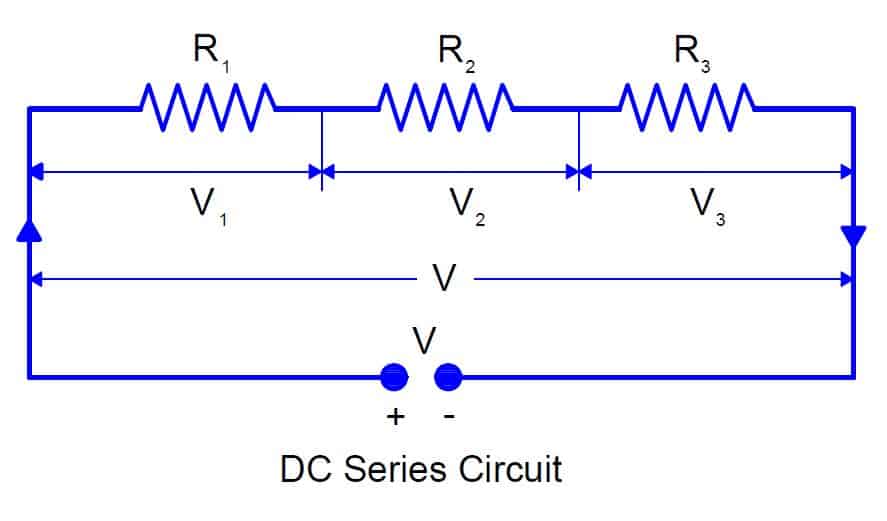
To calculate the total resistance, current, and voltage in a series DC circuit, the following steps may be followed:
- Determine the resistance of each component in the circuit. This can be done using the colour code on the resistor or by measuring the resistance with a multimeter.
- Calculate the total resistance of the circuit by adding the resistances of all components. For a series circuit, the total resistance is simply the sum of the individual resistances.
Total Resistance (Rt) = R1 + R2 + R3 + …
Determine the source voltage (Vs) of the circuit. This is the voltage applied to the circuit by the power source. Calculate the current (I) flowing through the circuit using Ohm’s Law:
I = Vs / Rt
Calculate the voltage (V) drop across each component in the circuit using Ohm’s Law:
V1 = I * R1 V2 = I * R2 V3 = I * R3 …
Note: The sum of the individual voltage drops should equal the total voltage of the circuit (Vs).
For example, consider a series circuit with two resistors, R1 = 100 ohms and R2 = 200 ohms, and a power source of 12 volts.
The total resistance of the circuit is:
Rt = R1 + R2 = 100 + 200 = 300 ohms
Using Ohm’s Law, we can calculate the current flowing through the circuit:
I = Vs / Rt = 12 / 300 = 0.04 amps or 40 milliamps
The voltage drop across each resistor can be calculated using Ohm’s Law:
V1 = I * R1 = 0.04 * 100 = 4 volts
V2 = I * R2 = 0.04 * 200 = 8 volts
Note that the sum of the individual voltage drops is equal to the total voltage of the circuit:
V1 + V2 = 4 + 8 = 12 volts
Parallel DC Circuit: In a parallel DC circuit, the components are connected in branches, with each branch providing a separate path for current to flow. The voltage across each branch is the same, but the current is divided among them according to their resistance. The total resistance of a parallel circuit is calculated using the reciprocal of the sum of the reciprocals of the individual resistances.
What is Direct Current? Calculation of the total resistance, current, and voltage in a parallel DC circuit
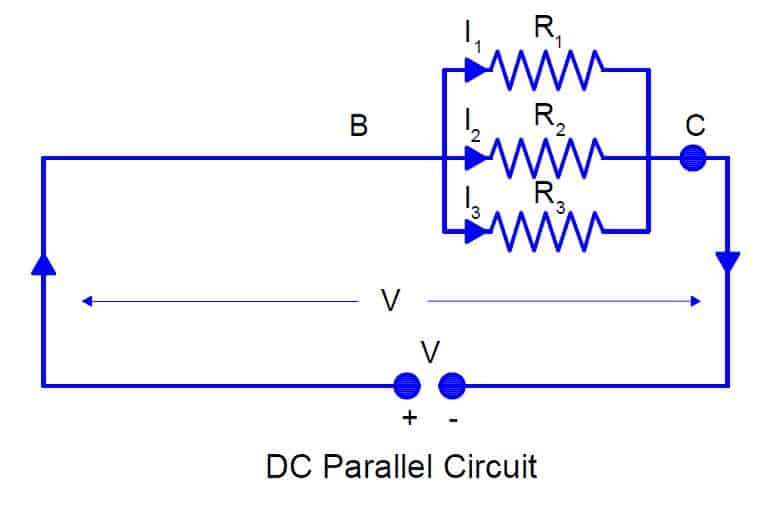
To calculate the total resistance, current, and voltage in a parallel DC circuit, the following steps are needed to be followed:
For the determination of the resistance of each component in the circuit, Calculate the total resistance of the circuit using the formula:
1/Rt = 1/R1 + 1/R2 + 1/R3 + …
Where,
- R1, R2, R3, etc. are the resistances of each component in the circuit.
Once you have the total resistance, you can calculate the current flowing through the circuit using Ohm’s Law:
I = Vs / Rt
Where,
- Vs is the voltage of the power source.
Calculate the voltage drop across each component in the circuit using Ohm’s Law:
V1 = I * R1 V2 = I * R2 V3 = I * R3 …
For example, consider a parallel circuit with two resistors, R1 = 100 ohms and R2 = 200 ohms, and a power source of 12 volts.
The total resistance of the circuit is:
1/Rt = 1/R1 + 1/R2 1/Rt = 1/100 + 1/200 1/Rt = 0.03 Rt = 33.33 ohms
The current flowing through the circuit can be calculated Using Ohm’s Law,
I = Vs / Rt = 12 / 33.33 = 0.36 amps or 360 milliamps
The voltage drop across each resistor can be calculated using Ohm’s Law:
V1 = I * R1 = 0.36 * 100 = 36 volts
V2 = I * R2 = 0.36 * 200 = 72 volts
What is direct current? Calculation of the total resistance, current, and voltage in a series-parallel DC circuit
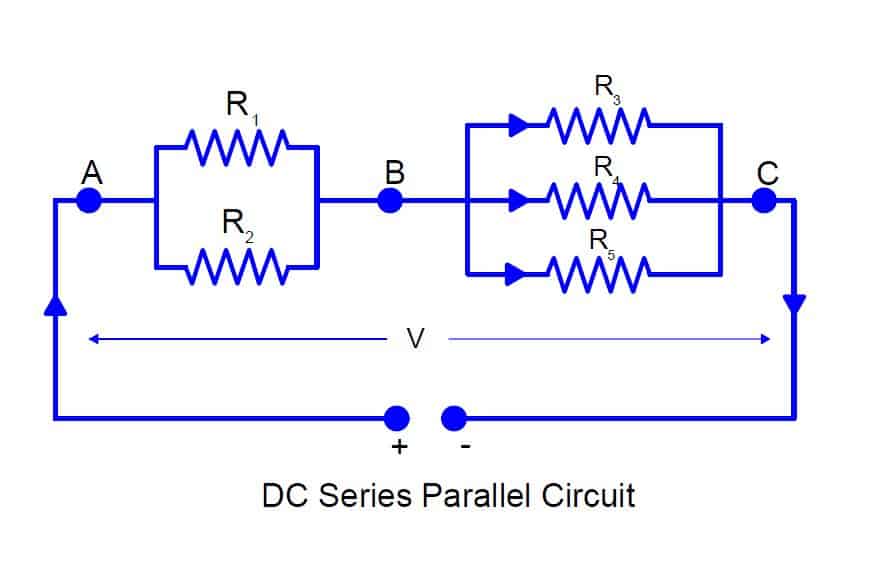
A series-parallel DC circuit is a combination of resistors that are connected in both series and parallel configurations. In this type of circuit, some resistors are connected in series with each other, while others are connected in parallel with each other. The combination of these configurations creates a complex circuit that requires careful analysis to determine the total resistance and current flow.
The total resistance of a series-parallel circuit:
To calculate the total resistance of a series-parallel circuit you must first identify the resistors that are connected in series and calculate their equivalent resistance using the formula:
Req = R1 + R2 + R3 + … + Rn
Where,
- Req is the equivalent resistance, and
- R1, R2, R3, …, Rn are the resistances connected in series.
Next, you must identify the resistors that are connected in parallel and calculate their equivalent resistance using the formula:
1/Req = 1/R4 + 1/R5 + 1/R6 + … + 1/Rm
Where,
- Req is the equivalent resistance, and
- R4, R5, R6, …, Rm are the resistances connected in parallel.
Once you have calculated the equivalent resistance of the series and parallel configurations, you can combine them to find the total resistance of the circuit.
The total resistance is calculated using the formula:
Rtot = Req1 + Req2 + Req3 + … + Reqp
Where,
- Rtot is the total resistance,
- Req1, Req2, Req3, …, Reqp are the equivalent resistances of the series and parallel configurations.
To calculate the total current flowing in the circuit Ohm’s law can be used which states that the current flowing through a conductor is equal to the voltage applied to the conductor divided by the resistance of the conductor.
The total current flowing in the circuit is calculated using the formula:
Itot = V/Rtot
Where,
- Itot is the total current,
- V is the applied voltage, and
- Rtot is the total resistance of the circuit.
It’s important to note that in a series-parallel circuit, the voltage across each resistor is different and depends on the resistance value of the resistor. The current flowing through each resistor is the same in a series configuration, while in a parallel configuration, the voltage across each resistor is the same, but the current flowing through each resistor is different.
The voltage drop In a series-parallel circuit.
In a series-parallel circuit, the voltage drop across each resistor in the series configuration is determined by the current flowing through the resistor and its resistance. The voltage drop across each resistor in the parallel configuration is the same, while the current flowing through each resistor is determined by its resistance. The total voltage drop across the resistors in the series configuration and the parallel configuration is the sum of the voltage drops across each individual resistor.
Therefore, in a series-parallel DC circuit, the voltage drop can occur across individual resistors, and the total voltage drop in the circuit is the sum of the voltage drops across each resistor
For example, consider a parallel circuit with three resistors, R1 = 10 ohms, R2 = 20 ohms, and R3 = 30 ohms, connected to a voltage source of 12 volts. We want to calculate the total resistance and total current flowing through the circuit.
To calculate the equivalent resistance of the parallel circuit, we use the formula:
1/Req = 1/R1 + 1/R2 + 1/R3
1/Req = 1/10 + 1/20 + 1/30
1/Req = 0.1 + 0.05 + 0.0333
1/Req = 0.1833
Req = 5.45 ohms
Therefore, the equivalent resistance of the parallel circuit is 5.45 ohms.
To calculate the total current flowing through the circuit, we use Ohm’s law:
Itot = V/Rtot
Itot = 12/5.45
Itot = 2.2 amps
Therefore, the total current flowing through the parallel circuit is 2.2 amps.
To calculate the current flowing through each resistor, we use Ohm’s law again, since the voltage drop across each resistor is the same:
I1 = V/R1 = 12/10 = 1.2 amps I2 = V/R2 = 12/20 = 0.6 amps I3 = V/R3 = 12/30 = 0.4 amps
Therefore, the current flowing through each resistor is 1.2 amps for R1, 0.6 amps for R2, and 0.4 amps for R3.
In this example, we have calculated the equivalent resistance and total current flowing through a parallel DC circuit. We have also calculated the current flowing through each resistor in the circuit using Ohm’s law.
What is Direct Current? Applications;
Direct current has numerous applications in modern technology and experience by common, including;
1. Electronics: DC is used to power electronic devices, such as computers, televisions, and smartphones.
2. Transportation: DC is used in electric vehicles, such as bikes, scooters, cars, buses, and trains.
3. Renewable energy: DC is used in solar panels, wind turbines, and other renewable energy systems to convert and store energy.
4. Welding: DC is used in welding machines to produce a steady flow of current that can be used to weld metals together.
5. Telecommunications: DC is used to power and regulate equipment in telecommunications systems, such as cell phone towers and satellite systems.
6. Medical devices: DC is used in medical devices, such as pacemakers, defibrillators, and electrocardiograms.
7. Electroplating: DC is used in electroplating and electroforming processes, which are used to coat metal objects with a thin layer of another metal.
8. Scientific research: DC is widely used in scientific research, particularly in fields such as electrochemistry, material science, and physics.
What is Direct Current?FAQs
01:Q: What is Direct Current (DC)?
A: Direct Current (DC) is an electric current that flows in one direction only. This is in contrast to Alternating Current (AC), which changes direction periodically.
02Q: How is Direct Current generated?
A: Direct Current can be generated in several ways, including batteries, fuel cells, solar cells, and dynamos.
03Q: What are the advantages of Direct Current?
A: Direct Current has several advantages over Alternating Current. It is more efficient for many electronic devices, has a lower voltage drop over long distances, and is easier to convert to other forms of energy.
04Q: What are the disadvantages of Direct Current?
A: Direct Current has some disadvantages as well, including the fact that it is more difficult to transmit over long distances without significant power loss. It also requires specialized equipment for high-voltage transmission.
05Q: Where is Direct Current used?
A: Direct Current is used in a wide range of applications, including batteries, electronic devices, transportation systems, and renewable energy sources such as solar cells.
06Q: What is the difference between Direct Current and Alternating Current? A: The main difference between Direct Current and Alternating Current is the direction in which the current flows. Direct Current flows in one direction only, while Alternating Current changes direction periodically.
07Q: How is Direct Current measured?
A: Direct Current is measured in amperes (A), which is a unit of electric current. The voltage of the Direct Current is measured in volts (V), and the power is measured in watts (W).
08Q: How can Direct Current be converted to Alternating Current?
A: Direct Current can be converted to Alternating Current using an inverter, which converts the DC voltage into an AC voltage with a frequency and waveform that can be adjusted for specific applications.
09Q: What are some common applications of Direct Current?
A: Some common applications of Direct Current include batteries, electronic devices, electric vehicles, and renewable energy systems such as solar cells and wind turbines.
What is Direct Current? Conclusion.
In summary, Direct current is a type of electrical current that flows in one direction only. It has many applications in modern technology, including electronics, transportation, renewable energy, welding, telecommunications, and medical devices. The formula for calculating the direct current flowing through a circuit is I = V/R, where I is current, V is voltage, and R is resistance.

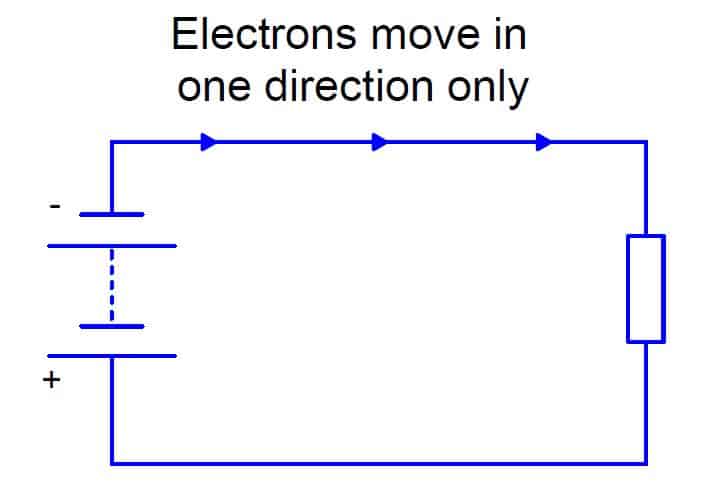

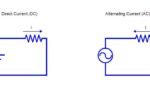
1 Comment
[…] has been discussed in length in this post. The main difference between Alternating current and Direct current is the direction of the flow of electric charge. Direct current (DC) is an electric current that […]